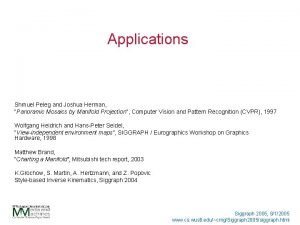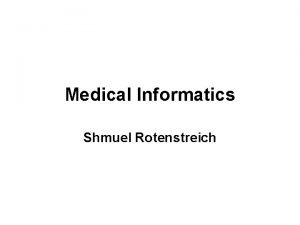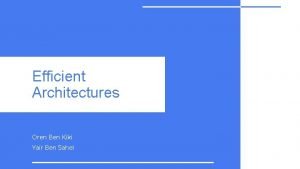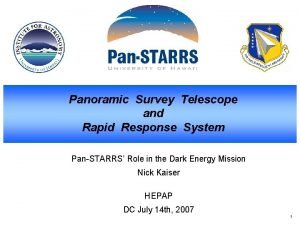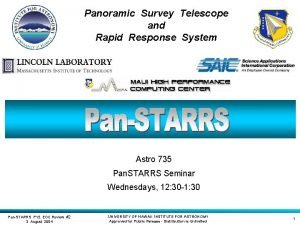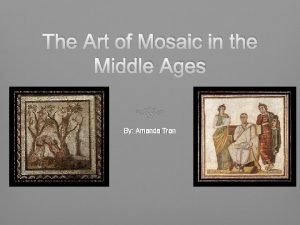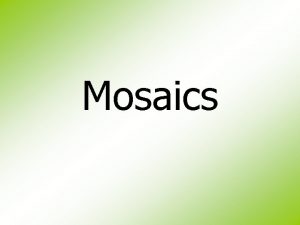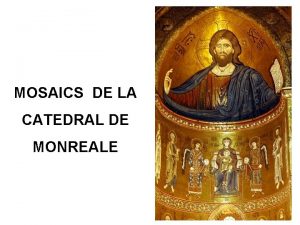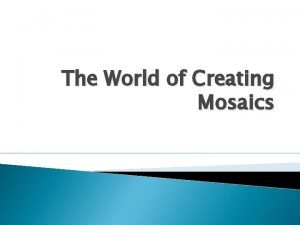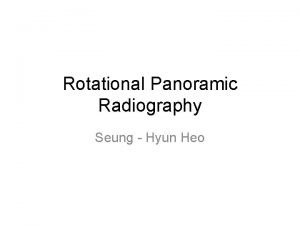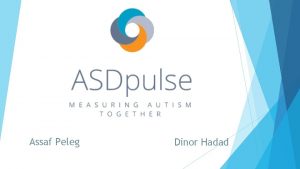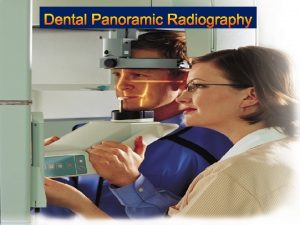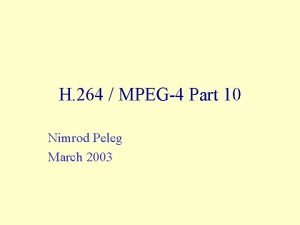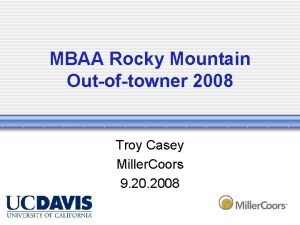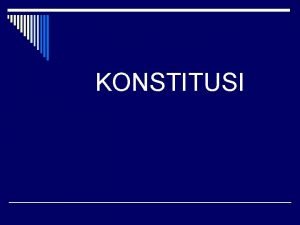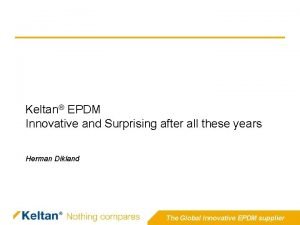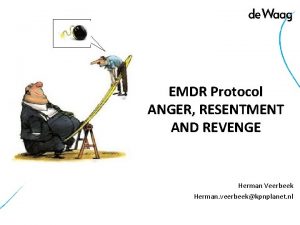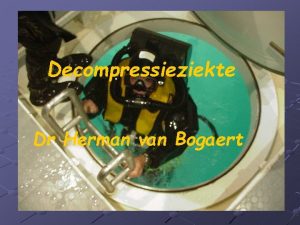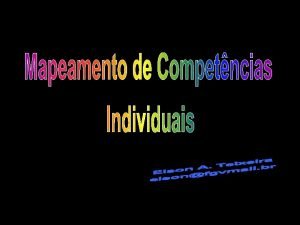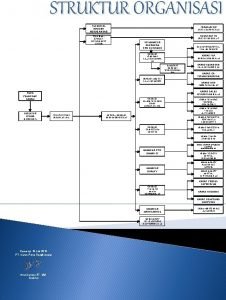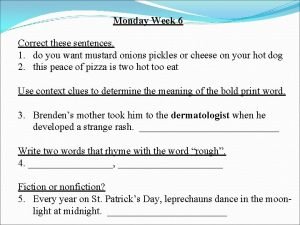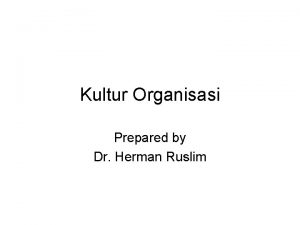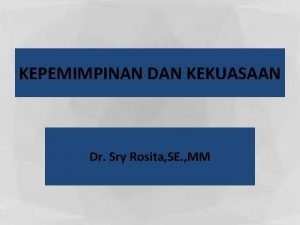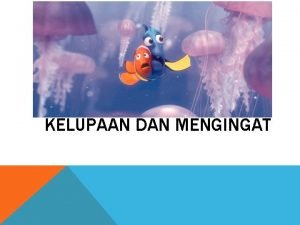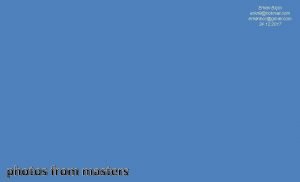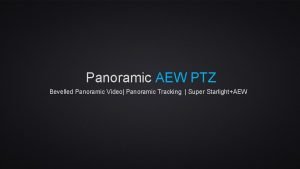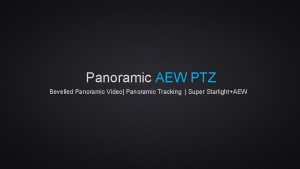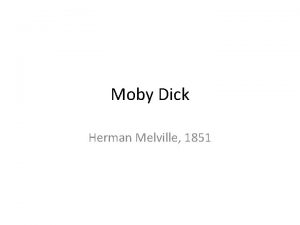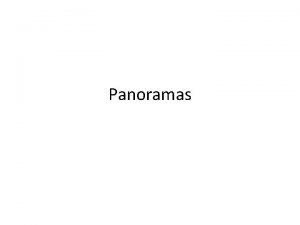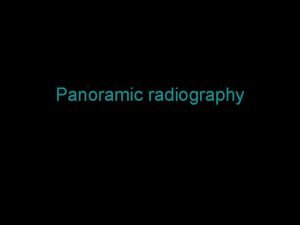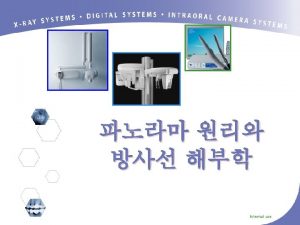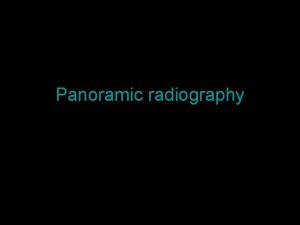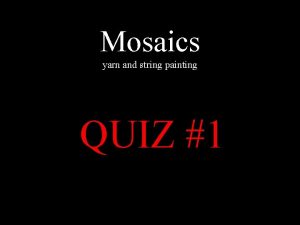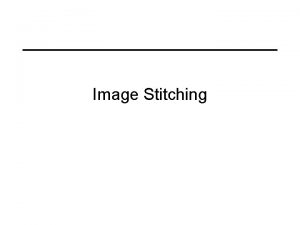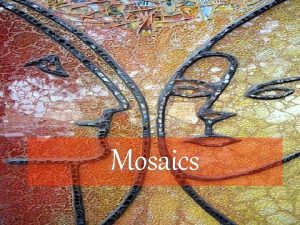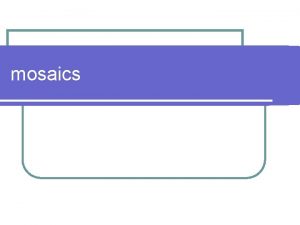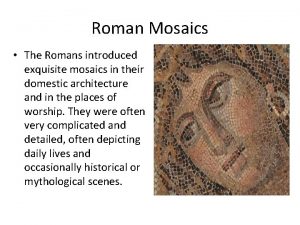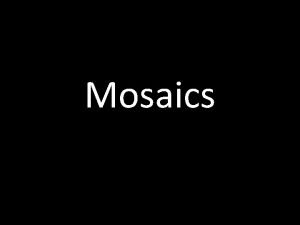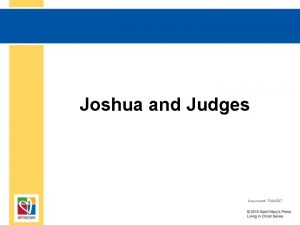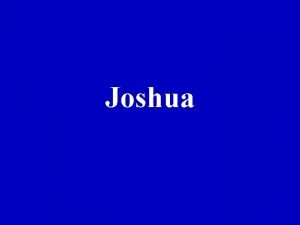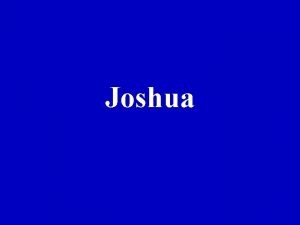Applications Shmuel Peleg and Joshua Herman Panoramic Mosaics


































- Slides: 34

Applications Shmuel Peleg and Joshua Herman, “Panoramic Mosaics by Manifold Projection”, Computer Vision and Pattern Recognition (CVPR), 1997 Wolfgang Heidrich and Hans-Peter Seidel, “View-independent environment maps”, SIGGRAPH / Eurographics Workshop on Graphics Hardware, 1998 Matthew Brand, “Charting a Manifold”, Mitsubishi tech report, 2003 K. Grochow, S. Martin, A. Hertzmann, and Z. Popovic Style-based Inverse Kinematics, Siggraph 2004 Siggraph 2005, 8/1/2005 www. cs. wustl. edu/~cmg/Siggraph 2005/siggraph. html

Applications using manifolds • Many problems can be phrased in manifold terminology • Provides an alternative way of viewing the problem • Can also provide some formalism 2 Siggraph 2005, 8/1/2005 www. cs. wustl. edu/~cmg/Siggraph 2005/siggraph. html

Applications • Surface fitting • Consistent parameterization • Image-based rendering • Environment mapping • Animation 3 Siggraph 2005, 8/1/2005 www. cs. wustl. edu/~cmg/Siggraph 2005/siggraph. html

Surface fitting • CT, MRI data, noisy, densely sampled in widely-spaced contours • Boundary conditions less problematic Fitting Manifold Surfaces To 3 D Point Clouds Cindy Grimm, David Laidlaw, and Joseph Crisco J. of Biomedical Engineering Feb. 2002 4 Siggraph 2005, 8/1/2005 www. cs. wustl. edu/~cmg/Siggraph 2005/siggraph. html

Consistent parameterization • Build manifold once • Fit to multiple bone point data sets 5 Siggraph 2005, 8/1/2005 www. cs. wustl. edu/~cmg/Siggraph 2005/siggraph. html

Aligning parameterization • Identify similar points on meshes • Pin parameterization 6 Siggraph 2005, 8/1/2005 www. cs. wustl. edu/~cmg/Siggraph 2005/siggraph. html

Application: Panoramas • Problem statement: • Given images from a known camera movement • Rotation about camera axis • “Push-broom” pan (assumes negligible depth) • “Glue” images together into a single image Rover, nasa. gov 7 Siggraph 2005, 8/1/2005 www. cs. wustl. edu/~cmg/Siggraph 2005/siggraph. html

Camera rotation • Final image can be rendered on a cylinder • No parallax • Each image samples some number of pixels on cylinder (manifold) image Peleg and Herman 8 Siggraph 2005, 8/1/2005 www. cs. wustl. edu/~cmg/Siggraph 2005/siggraph. html

Push broom/vertical slit camera • Translation of camera • Image slit perpendicular to camera motion • Need not travel in straight line • Depth differences negligible • Parallax • Manifold is part of ground plane viewed by camera Peleg and Herman Direction of travel Ground plane 9 Siggraph 2005, 8/1/2005 www. cs. wustl. edu/~cmg/Siggraph 2005/siggraph. html

Practical problem • How to line up individual images to create one seamless image? • Manifold: Final image (3 D function RGB on 2 D manifold) • Charts: Individual images (2 D charts) • Overlap regions/transition functions: Unknown • Assume translation • (Account for optical effects of camera) • Note: Only works for these two camera motions 10 Siggraph 2005, 8/1/2005 www. cs. wustl. edu/~cmg/Siggraph 2005/siggraph. html

General solution • Define a format for the transition function • E. g. , translation in x, y • Define an error metric that measures how well two overlap regions agree • E. g. , pixel difference • Optimize over free parameters in transition function • E. g. , x, y shift between all pairs of overlapping images 11 Siggraph 2005, 8/1/2005 www. cs. wustl. edu/~cmg/Siggraph 2005/siggraph. html

Solving for overlaps, transitions • Find translation that minimizes pixel differences • Find y that minimizes || I 0(s) – I 1(y(s))|| • y(s) = s + Ds, where Ds is unknown 0 1 Ds 12 Siggraph 2005, 8/1/2005 www. cs. wustl. edu/~cmg/Siggraph 2005/siggraph. html

Final image • Transition functions align images (abstract manifold) • Final image colors? (RGB function on manifold) • Blend and embedding functions for each chart • Embedding function: Original image • Blending function: How much to use of each overlapping image • Usually favor very short blend regions 13 Siggraph 2005, 8/1/2005 www. cs. wustl. edu/~cmg/Siggraph 2005/siggraph. html

Application: Environment mapping • Place scene/model inside sphere • Light intensity/color found by intersecting normal with sphere • 1 -1 mapping between normal direction and sphere • Every point on sphere assigned light intensity/color • Implementation • Store colors in one (or more) texture maps (2 D) 15 Siggraph 2005, 8/1/2005 www. cs. wustl. edu/~cmg/Siggraph 2005/siggraph. html

Parameterization • Surface normal (point on sphere) to point in texture map • Atlas/local parameterization • Desirable properties • Even sampling of sphere • Adaptive • Partition • Overlap (mip mapping, continuity) • Simple to compute • Amenable to GPU implementation 16 Siggraph 2005, 8/1/2005 www. cs. wustl. edu/~cmg/Siggraph 2005/siggraph. html

Approach 1 • Single texture map • Not unique (poles) • Poor sampling • Simple to compute 17 Siggraph 2005, 8/1/2005 www. cs. wustl. edu/~cmg/Siggraph 2005/siggraph. html

Approach II • Cube mapping • Six charts • Discontinuities at edges • Sampling better at center of faces than edges • Simple (plane) computation • Which plane? 18 Siggraph 2005, 8/1/2005 www. cs. wustl. edu/~cmg/Siggraph 2005/siggraph. html

Approach III • Parabolic mapping • Chart functions use parabolic function • Better sampling • Slightly more computation • Less-noticeable seams 19 Heidrich and Hans-Peter Seidel Siggraph 2005, 8/1/2005 www. cs. wustl. edu/~cmg/Siggraph 2005/siggraph. html

Proposal • Use chart approach • Allows for adaptive sampling (more detail where needed) • Chart sizes uniform: Tile texture map • Include overlap • Minimal extra texture map • Mip-mapping/down sampling 20 Siggraph 2005, 8/1/2005 www. cs. wustl. edu/~cmg/Siggraph 2005/siggraph. html

Application: Animation • Human configuration space lies on a manifold of dimension n embedded in m dimensional space, where n << m • Articulated skeleton: over 40 degrees of freedom (shoulders, knees, hips, etc. , each 13 degrees of rotation) • Individual motions (reaching, walking) certainly lie on lower dimension manifolds • End-point of reach plus time • Shape of manifold of all possible human motions? • Who knows? K. Grochow, S. Martin, A. Hertzmann, and Z. Popovic 21 Siggraph 2005, 8/1/2005 www. cs. wustl. edu/~cmg/Siggraph 2005/siggraph. html

Overview • Manifold learning • Data samples (e. g. , motion capture, key frames) • Interpolation equals manifold construction • Editing equals manifold editing • High-level review of manifold learning techniques • What kind of manifolds can you learn/construct from data? • 2 D animation example • Manifolds in animation 22 Siggraph 2005, 8/1/2005 www. cs. wustl. edu/~cmg/Siggraph 2005/siggraph. html

2 D illustration • Two joint angles • Circle X Circle manifold (torus) • Animation • Repetitive motion • Joint angle plot • Circle manifold • Animation is a 1 D manifold embedded in 2 D 23 Siggraph 2005, 8/1/2005 www. cs. wustl. edu/~cmg/Siggraph 2005/siggraph. html

2 D illustration • Two joint angles • Circle X Circle manifold (torus) • Animation • Repetitive motion • Joint angle plot • Circle manifold • Animation is a 1 D manifold embedded in 2 D 24 Siggraph 2005, 8/1/2005 www. cs. wustl. edu/~cmg/Siggraph 2005/siggraph. html

Manifold learning • Input: Sample points in Rm • E. g. , Motion capture sequence, each pose is a data point, m is number of dof of joints • 2 D example: q, f for each pose • Assume data lies on a manifold of dimension n • Constraints on manifold shape/geometry (e. g. , linear, no self-intersections) • Goal: Parameterize manifold • Single chart 25 Siggraph 2005, 8/1/2005 www. cs. wustl. edu/~cmg/Siggraph 2005/siggraph. html

Manifold learning, linear techniques • Principal components analysis (PCA), Independent components analysis (ICA) • Assumes shape of manifold in space is linear/planar • Learn vector(s) that span the hyper-plane 26 Siggraph 2005, 8/1/2005 www. cs. wustl. edu/~cmg/Siggraph 2005/siggraph. html

Manifold learning, deformed linear • Support vector machines (SVM) • Deform space points are in first • Deformation is “nice” • Warps points to new places • “Guess” which deformation will work • Learn linear/planar function Deformation 27 Linear parameterization Siggraph 2005, 8/1/2005 www. cs. wustl. edu/~cmg/Siggraph 2005/siggraph. html

Manifold learning, local shape • Isomap, Local linear embedding (LLE), Semi-definite embedding (SDE) • Define a distance metric between points • Assumptions: • K closest neighbors are also closest K neighbors on the manifold • Disk around point in manifold would contain all K neighbors, but not others • Know dimension n of manifold • Possible to deform K neighbors into n dimensions while maintaining (relative) distances • Output: Single chart/parameterization of entire data set 28 Siggraph 2005, 8/1/2005 www. cs. wustl. edu/~cmg/Siggraph 2005/siggraph. html

Isomap, LLE, SDE cont. • Non-obvious failure modes • Circular/repetitive data sets • Self-intersections Modified : 1 D embedding Raw result: 2 D embedding 29 Siggraph 2005, 8/1/2005 www. cs. wustl. edu/~cmg/Siggraph 2005/siggraph. html

Manifold construction as learning • Use K neighbors to define chart domains (Uc) • Charts are “squished” Gaussians • Center, tangent vectors • Find transition functions (affine transformations) • Transformation takes tangent vectors into Rn • Aligns free vectors with neighbors Uc Matthew Brand, “Charting a Manifold”, Mitsubishi tech report, 2003 30 Siggraph 2005, 8/1/2005 www. cs. wustl. edu/~cmg/Siggraph 2005/siggraph. html

Uses of animation manifold • General idea: • Construct (implicitly or explicitly) a manifold representing valid human poses • Create a new animation sequence • Foot must touch here, reach here, etc. • Not sufficient to constrain all degrees of freedom (dof) • Project on to manifold to fill in remaining dof K. Grochow, S. L. Martin, A. Hertzmann, Z. Popovic, Style-Based Inverse Kinematics, Siggraph 2004 31 Siggraph 2005, 8/1/2005 www. cs. wustl. edu/~cmg/Siggraph 2005/siggraph. html

Re-sequencing as embedded manifold • Goal: Given existing sequence (samples), add more/change samples • Assumptions: • Samples come from some smooth manifold • Some form of interpolation gives new samples on manifold • Current approaches: Interpolation between neighboring samples in sequence for given new time 32 Siggraph 2005, 8/1/2005 www. cs. wustl. edu/~cmg/Siggraph 2005/siggraph. html

Re-phrasing problem • Manifold learning or sequence timing provides parameterization/abstract manifold • Embed manifold with smooth function • Parameterization • Use function fitting • Re-sequencing: Evaluate embedding function E(M) 33 Siggraph 2005, 8/1/2005 www. cs. wustl. edu/~cmg/Siggraph 2005/siggraph. html

Caveats • What makes animation data difficult? • “Distance” loses meaning in >> 10 dimensions • Every point equally far away • Can’t enumerate • Noise • Error in capture process • Skeleton only approximates human motion • Joint angle representation • Don’t explicitly deal with manifold, parameterization 34 Siggraph 2005, 8/1/2005 www. cs. wustl. edu/~cmg/Siggraph 2005/siggraph. html

Summary • Manifolds provide a formalism for breaking a problem into manageable pieces • Charts provide local parameterization • Planar domains • Overlaps: Natural mechanism for moving between parameterizations • Blend functions instead of geometric constraints • No boundary condition problems • Explicitly encapsulating/representing manifold is beneficial • Cleaner algorithm specifications 35 Siggraph 2005, 8/1/2005 www. cs. wustl. edu/~cmg/Siggraph 2005/siggraph. html
 Shmuel peleg
Shmuel peleg Shmuel oren
Shmuel oren Oren ben-kiki
Oren ben-kiki Panoramic survey telescope and rapid response system
Panoramic survey telescope and rapid response system University of hawaii
University of hawaii Mosaic art in medieval period
Mosaic art in medieval period History of mosaics
History of mosaics Mosaics de l’absis de la catedral de monreale
Mosaics de l’absis de la catedral de monreale Universal unity mosaics
Universal unity mosaics Hypercalciemia
Hypercalciemia Focal trough in panoramic radiography
Focal trough in panoramic radiography Ran peleg
Ran peleg Assaf peleg
Assaf peleg Focal trough dental definition
Focal trough dental definition Nimrod peleg
Nimrod peleg Herman middle school
Herman middle school Herman schmit
Herman schmit Herman joseph's private reserve
Herman joseph's private reserve Verfassunglehre
Verfassunglehre Keltan
Keltan Herman veerbeek
Herman veerbeek Herman van bogaert
Herman van bogaert Ned herman
Ned herman Cap-om certification
Cap-om certification Herman dolce
Herman dolce Herman ruslim
Herman ruslim 6.correct the sentences
6.correct the sentences Examples of indigenous
Examples of indigenous Herman ruslim
Herman ruslim Herman ruslim
Herman ruslim Herman ruslim
Herman ruslim Nebelgedicht
Nebelgedicht Hannah hernan cortes actress
Hannah hernan cortes actress 9hotmail
9hotmail Tom herman govworks
Tom herman govworks
